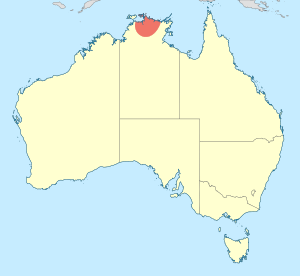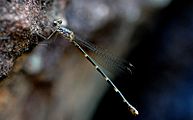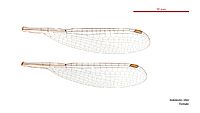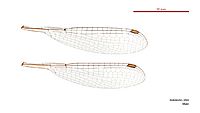Cave reedling facts for kids
Quick facts for kids Cave reedling |
|
|---|---|
 |
|
| Female, Northern Territory, Australia | |
| Conservation status | |
| Scientific classification | |
 |
The cave reedling (scientific name: Indolestes obiri) is a special kind of damselfly. It belongs to the Lestidae family. Damselflies are flying insects, a bit like dragonflies, but they are usually smaller and hold their wings differently when they rest.
This damselfly is found only in one place: Arnhem Land in the Northern Territory, Australia. When an animal or plant is found only in one specific area, it is called endemic to that place. The cave reedling likes to live near shallow, rocky pools of water.
It is a medium-sized damselfly with dull colours.
Contents
Meet the Cave Reedling
The cave reedling is a fascinating insect that spends its life near water. It's part of a group of insects called Odonata, which includes both damselflies and dragonflies. These insects are known for their amazing flying skills and their beautiful, often shiny, wings.
Where Does It Live?
The cave reedling calls Arnhem Land in Northern Territory, Australia, its only home. This area is known for its rugged sandstone country and many rock formations, which is why it's called a "cave" reedling. It prefers to live around shallow pools that form in rocky areas. These pools are important for the damselfly's entire life cycle.
What Does It Look Like?
This damselfly is not as brightly coloured as some other damselflies you might see. It has a medium size and its body colours are usually dull. Like all damselflies, it has two pairs of wings that are usually clear or slightly tinted. When it rests, it holds its wings folded back over its body, which is a key way to tell it apart from a dragonfly.
Its Life in the Water
Damselflies, including the cave reedling, start their lives in water. The female lays her eggs in or near the shallow pools. When the eggs hatch, tiny nymphs (young damselflies) emerge. These nymphs live underwater, hunting small aquatic creatures. They breathe using gills. After growing and shedding their skin several times, they crawl out of the water, and the adult damselfly emerges, ready to fly and find a mate.
Why Is It Special?
The cave reedling is considered a vulnerable species. This means its population is decreasing, and it could be at risk of disappearing if we don't protect its home. Because it lives only in Arnhem Land and relies on specific shallow, rocky pools, it's very important to protect these habitats. Scientists study these damselflies to understand how to help them survive and thrive.
Gallery





